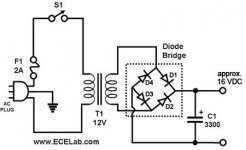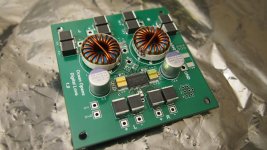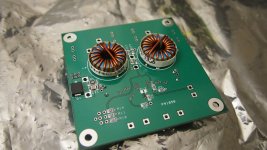OK, would a better potentiometer in the same form factor be better ? I have 50 kOhm Alps ones that seem to fit. No idea what the value of the potentiometer on these boards is as don't have one yet.
Just ordered the YuanJing board which is on sale now at their own website. I am very curious after reading the comments here.
Just ordered the YuanJing board which is on sale now at their own website. I am very curious after reading the comments here.
OK, would a better potentiometer in the same form factor be better ?
As long as it's not on the board itself.
I know this might seem absurd but "if" these boards are as good as so many feel they are then maybe a very high end potentiometer like a Goldpoint Compare Attenuator Types would not be out of line. Seems crazy to pay multiples of the price for the potentiometer but if it helps get the max sound quality out well.......If others know of comparable quality at cheaper prices I'd love to know.
Any stepped attenuator would be an improvement over a normal potentiometer. They can be had much cheaper though. And you can DIY them too.
Here comes a link 1pc 4x24 Step Hi End Goldplate Attenuator Potentiometer | eBay
If it doesnt come up, Search: 1pc 4X24 step HI-End Goldplate Attenuator
Im new on this so i wonder what is the difference between, 24x2 and 24x4 (poles).
And the one i sent, is it ready to use? Its stepped attenuator but better price then the one you sent that was 150 usd. But maybe that one is much better?
If it doesnt come up, Search: 1pc 4X24 step HI-End Goldplate Attenuator
Im new on this so i wonder what is the difference between, 24x2 and 24x4 (poles).
And the one i sent, is it ready to use? Its stepped attenuator but better price then the one you sent that was 150 usd. But maybe that one is much better?
2 poles is mono.
http://www.ebay.com/itm/1PC-DALE-4-...entiometer-Dual-50K-Ladder-Type-/221267863108
Search term: 1PC DALE 4×24 Step Attenuator
This one seems reasonably priced for a sealed one with silver contacts and Dale (Vishay) resistors directly soldered to pins. Don't think you can realistically do much better than that.
http://www.ebay.com/itm/1PC-DALE-4-...entiometer-Dual-50K-Ladder-Type-/221267863108
Search term: 1PC DALE 4×24 Step Attenuator
This one seems reasonably priced for a sealed one with silver contacts and Dale (Vishay) resistors directly soldered to pins. Don't think you can realistically do much better than that.
Last edited:
Okay thanks.
Wouldnt this transformer works for the amp?
Search on ebay as:
Ringkerntrafo prim 230 V 50 Hz sek 22,2 V
Wouldnt this transformer works for the amp?
Search on ebay as:
Ringkerntrafo prim 230 V 50 Hz sek 22,2 V
Okay thanks.
Wouldnt this transformer works for the amp?
Search on ebay as:
Ringkerntrafo prim 230 V 50 Hz sek 22,2 V
No.
Can you explain why?
And could you give me a link on a transformer that would be perfect?
Maybe this will work better, i use 19v laptop today.
Search ebay
24V 4A LCD Monitor Printer AC Adapter Power Supply Cord
And could you give me a link on a transformer that would be perfect?
Maybe this will work better, i use 19v laptop today.
Search ebay
24V 4A LCD Monitor Printer AC Adapter Power Supply Cord
Last edited:
I know this might seem absurd but "if" these boards are as good as so many feel they are then maybe a very high end potentiometer like a Goldpoint Compare Attenuator Types would not be out of line. Seems crazy to pay multiples of the price for the potentiometer but if it helps get the max sound quality out well.......If others know of comparable quality at cheaper prices I'd love to know.
There are plenty of great pots on ebay much cheaper than Goldpoint, not to mention all the LDR/optocoupler designs as well. Goldpoints are so ten years ago.😛
Can you explain why?
I'm sorry but you should really read some basics about electronics before venturing into trying to build a power supply from scratch. It will serve you well in the future as you will know why some things works, and others don't. I apologize if this comes across as blunt but at the end of the day there is no getting around learning it the hard way (by reading books).
I see, i found one good page about it, but it doesnt seem to be as easy as i thought, the page was Solid State Power Amplifier Supply Part 2
Maybe the easiest is to use a 24v "laptop" supply.
Maybe the easiest is to use a 24v "laptop" supply.
You have to take into account that the 22 V AC will be approx. 1.4 x a DC voltage after rectifying and buffering. So lets say more than 30 V DC unregulated. The chip will fry.
For 22 V DC a 15 V 3 A (or more) "real" transformer (so copper wires around a iron/ferrite core) will work with a rectifier and large buffer cap. I would use 10.000 or 22.000 µF rated for 35 V or higher. You won't be able to adjust voltage and it will be unregulated voltage unlike switched PSU's. The chip won't fry but any experiments like running it at exactly 20.5 V won't be possible. Can't be beat for simplicity and reliability though. With switchers you have one certainty: they will fail, you only don't know when.
I am exaggerating of course but old fashioned transformers are reliable.
See this very simple schematic and use a 15 V transformer with primaries that are suitable for your local mains voltage and the 10.000 µF or 22.000 µF 35 V for C1. Use a diode bridge that can handle the inrush current. An 100 V 8 A rated bridge will certainly suffice. The ones with Faston connectors are easy to work with and most are rated way more than 8 A. The link matthtvr gave is a good one but for TPA3116 you don't need symmetrical supplies ( so +, 0, -), you only need + 20 V and GND. If all this is too much then don't bother and use a laptop adapter.
For 22 V DC a 15 V 3 A (or more) "real" transformer (so copper wires around a iron/ferrite core) will work with a rectifier and large buffer cap. I would use 10.000 or 22.000 µF rated for 35 V or higher. You won't be able to adjust voltage and it will be unregulated voltage unlike switched PSU's. The chip won't fry but any experiments like running it at exactly 20.5 V won't be possible. Can't be beat for simplicity and reliability though. With switchers you have one certainty: they will fail, you only don't know when.
I am exaggerating of course but old fashioned transformers are reliable.
See this very simple schematic and use a 15 V transformer with primaries that are suitable for your local mains voltage and the 10.000 µF or 22.000 µF 35 V for C1. Use a diode bridge that can handle the inrush current. An 100 V 8 A rated bridge will certainly suffice. The ones with Faston connectors are easy to work with and most are rated way more than 8 A. The link matthtvr gave is a good one but for TPA3116 you don't need symmetrical supplies ( so +, 0, -), you only need + 20 V and GND. If all this is too much then don't bother and use a laptop adapter.
Attachments
Last edited:
Love this thread 🙂 I gained a lot of insight... Thank U 😛
Attachments
Last edited:
OK, would a better potentiometer in the same form factor be better ? I have 50 kOhm Alps ones that seem to fit. No idea what the value of the potentiometer on these boards is as don't have one yet.
Just ordered the YuanJing board which is on sale now at their own website. I am very curious after reading the comments here.
I measured it quite sometime ago. I think it is 100K
Regards,
Here comes a link 1pc 4x24 Step Hi End Goldplate Attenuator Potentiometer | eBay
If it doesnt come up, Search: 1pc 4X24 step HI-End Goldplate Attenuator
Im new on this so i wonder what is the difference between, 24x2 and 24x4 (poles).
And the one i sent, is it ready to use? Its stepped attenuator but better price then the one you sent that was 150 usd. But maybe that one is much better?
Or you can try this one.
Aliexpress.com : Buy Child 1195 100% cotton long sleeve dance clothes female child autumn ballet leotard costume from Reliable costume tweed suppliers on frank mo's store.
Quite a bit cheaper but only 21 steps. It uses SMD resistors, that's why it is so much smaller. There are other sellers at EBay selling the same thing at higher prices. The feedbacks on this step attenuator (at EBay) are quite good.
I have seen other variations using smd resistors too e.g.
ebay.com/itm/Valab-23-Step-Attenuator-Potentiometer-50K-Log-Stereo-/281138265590?pt=US_Amplifier_Parts_Components&hash=item4175257df6
Regards,
Love this thread 🙂 I gained a lot of insight... Thank U 😛
Is this board your own design? Looks beautiful and very compact. It looks like you managed to fit under 5cm x 5cm size for the low cost boards at qnty 10 for $15.
I assume this is the parallel bridged mono? How does it sound?

Love this thread 🙂 I gained a lot of insight... Thank U 😛
Would love to have one of these boards. They look stunning. You are not having spares do you ? 🙂
The large caps (C1, C2 etc.) look like film caps. Or are they ceramic ones ?
Last edited:
Love this thread 🙂 I gained a lot of insight... Thank U 😛
Those boards look ... 'serene' is the best word I can think of, maybe it's the silkscreen planting suggestions in my mind.
It is the 3118 though, correct? any reason you chose that over the 3116?
- Home
- Amplifiers
- Class D
- TPA3116D2 Amp


